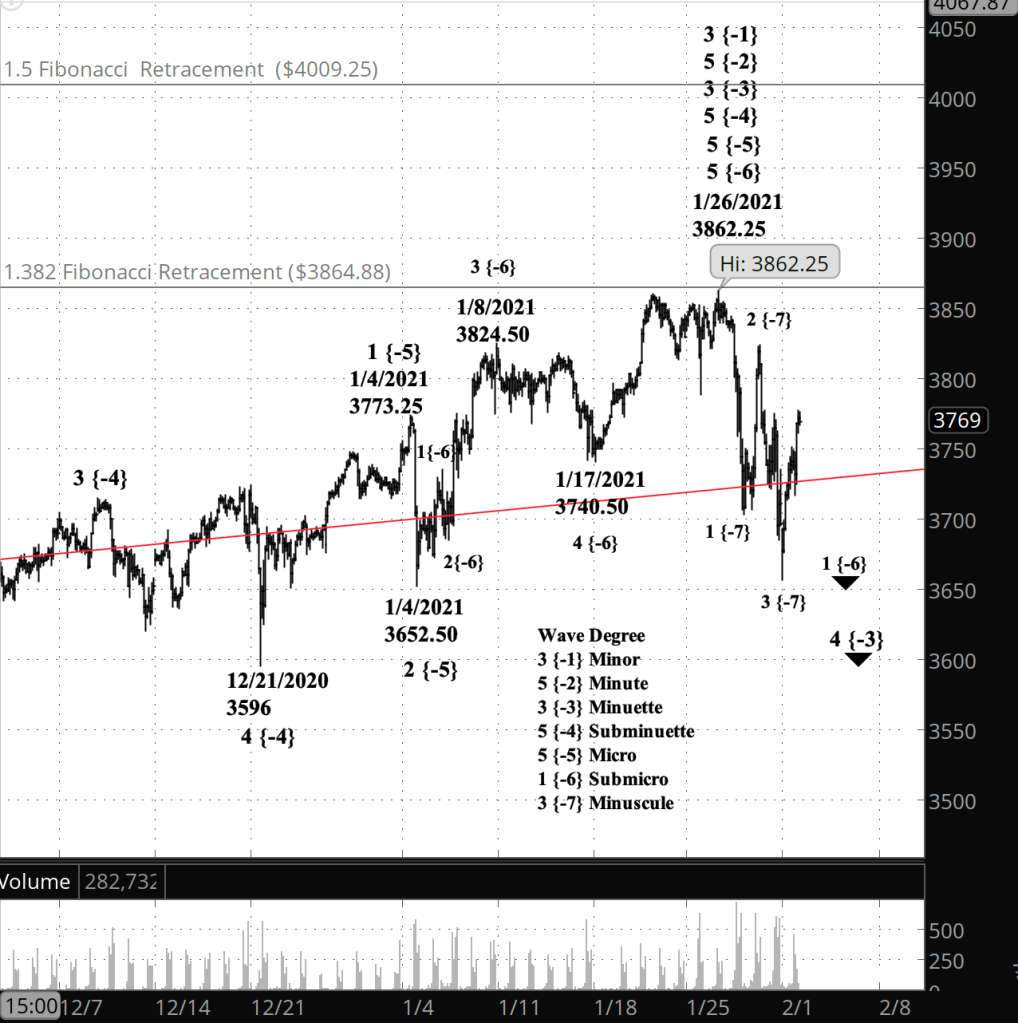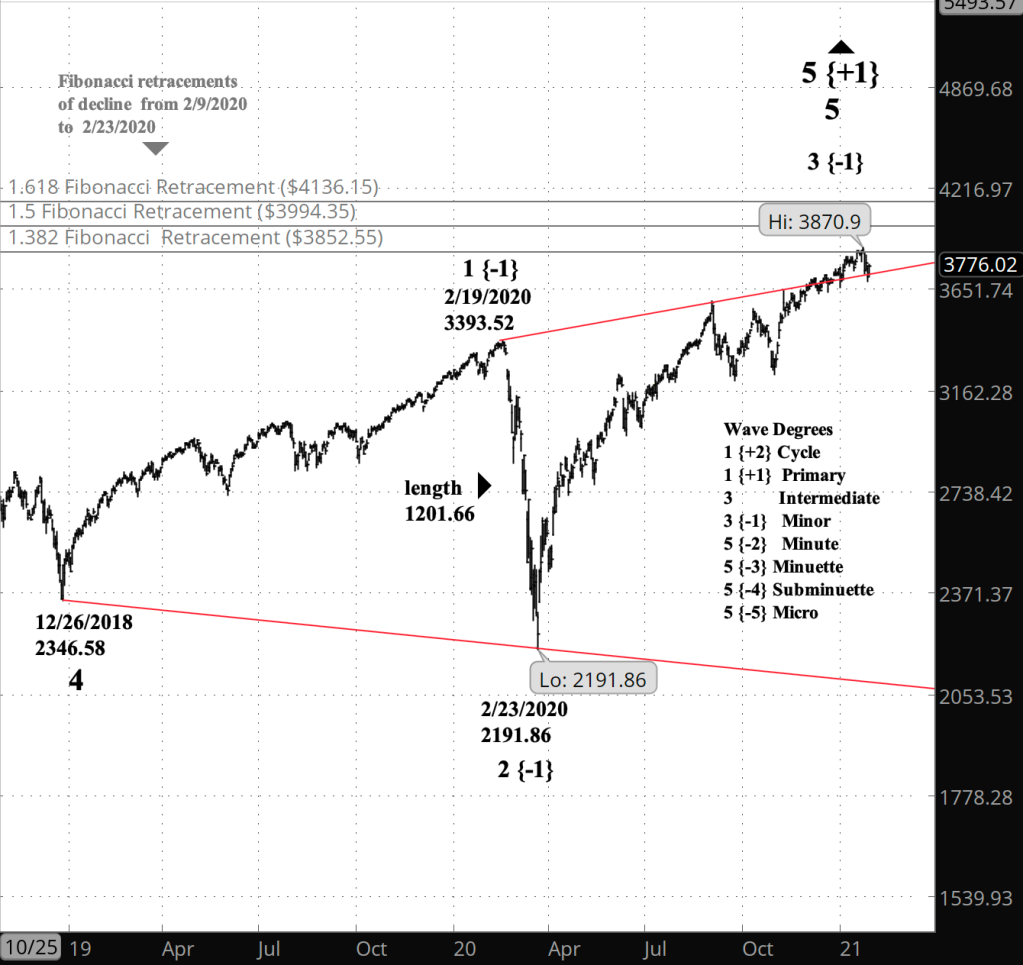3:30 p.m. New York time
Half an hour before the closing bell. The S&P 500 continued to work through a rising counter-trend correction within the first Submicro degree wave of a downward move that began on January 26. I’ve updated the charts below.
9:50 a.m. New York time
What’s happening now? The S&P 500 E-mini futures continued to work their way lower, in a series of lower highs and lower lows — the classic definition of a downtrend. After reaching a low of 3656.50 in overnight trading, the price retraced upward by 95 points. The decline began on January 26 from 3862.25, which is 5% above the the low so far.
What does it mean? The decline is the beginning of a large-scale downtrend that will eventually work its way down around 2000. But there will be much drama to be seen between now and then.

What does Elliott wave theory say? The downtrend that began on January 26 is wave 1 of Submicro degree. Within Subicro 1, wave 3 of Minuscule degree appears ready to begin its decline after a 2nd wave retracement to the upside.
The price has hit the 1.382 Fibonacci retracement of the decline that began on February 19, 2020 and ended four days later, 1,202 points lower. The decline was part of a Diagonal Triangle pattern that began in December 2018. The red line on the chart is the upper boundary of that triangle, and the lower boundary at present is at about 2100.
The rise since February 23, 2020 has been wave 3 of Minor degree, and the decline that began January 26, 2021 is wave 4 of Minor degree. Fourth wave correction tend to be shall in a normal five-wave trend. However, in triangles the price bounces between boundaries set at the beginning of waves 1 and 3 and the beginning of wave 2. The 4th wave in this instance will carry the price a great distance so that reaches or comes close to the lower boundary of the Diagonal Triangle. Here’s a big-view chart that shows the entire S&P 500 index triangle so far.

Learning and other resources. Elliott Wave International has long been the leading analytical house based on Elliott wave theory. They make available a number of free educational materials and other resources, in addition to their for-pay subscriptions.
I recommend two books, both by people associated with EWI.
First, Elliott Wave Principle by Robert Prechter and A.J. Frost is the book that, along with Prechter’s analyses, that created the revival of Elliott wave theory. I first read it in 1984, and it has had a profound influenced on my thinking about markets ever since.
Second, I’ve found Visual Guide to Elliott Wave Trading by Wayne Gorman and Jeffrey Kennedy, both of EWI, to be a useful book that relates Elliott wave theory to practical trading. The authors are hands-on Elliotticians, and for an active trader, that’s exactly what’s needed — less theory and more how-to. The first chapter of the book gives a very nice thumbnail run down of what Elliott wave theory is all about.
Terminology. Here are some links to information about some of the technical jargon I use.
Charts. On my charts, waves have a subscript showing the degree above or below the Intermediate degree. Here are the subscripts and the degree each represents:
- {+3} Supercycle
- {+2} Cycle
- {+1} Primary
- No subscript: Intermediate
- {-1} Minor
- {-2} Minute
- {-3} Minuette
- {-4} Subminuette
- {-5} Micro
- {-6} Submicro
- {-7} Minuscule
By Tim Bovee, Portland, Oregon, February 1, 2021
Disclaimer
Tim Bovee, Private Trader tracks the analysis and trades of a private trader for his own accounts. Nothing in this blog constitutes a recommendation to buy or sell stocks, options or any other financial instrument. The only purpose of this blog is to provide education and entertainment.
No trader is ever 100 percent successful in his or her trades. Trading in the stock and option markets is risky and uncertain. Each trader must make trading decisions for his or her own account, and take responsibility for the consequences.
All content on Tim Bovee, Private Trader by Timothy K. Bovee is licensed under a Creative Commons Attribution-ShareAlike 4.0 International License.
Based on a work at www.timbovee.com.

You must be logged in to post a comment.